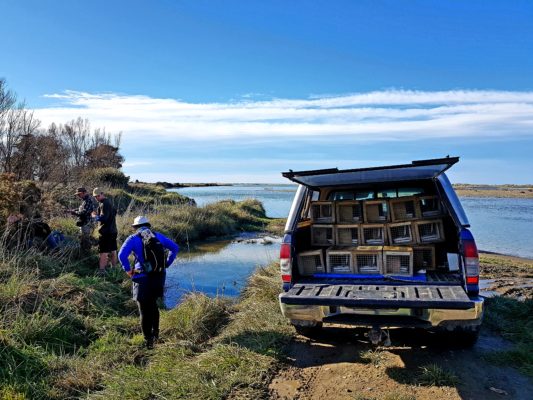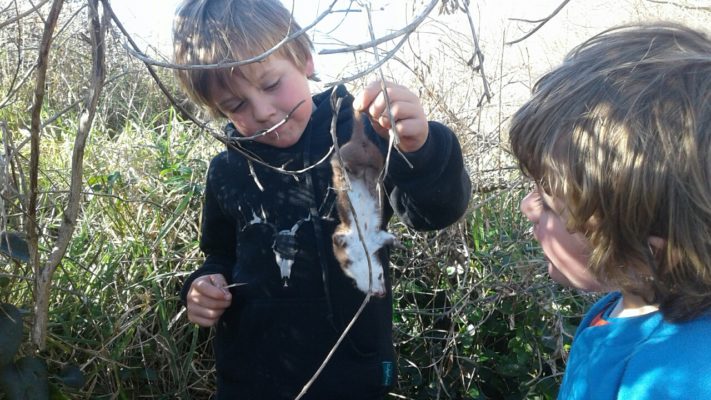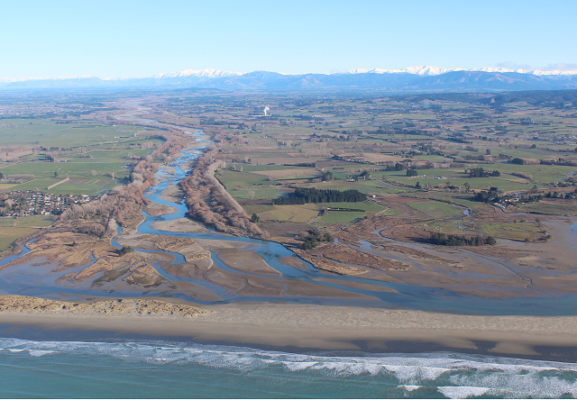Arlo Poore is only 5 years old – but he’s already something of an experienced trapper. He regularly helps Dad, Stuart, check his two traplines on the Ashley rivermouth and estuary near Waikuku in North Canterbury.
“Arlo gets excited when we’ve caught something,” says Stuart. “He’s good at recognising stoats, weasels and rats. We get a lot more weasels than stoats.”

Younger brother Otis (aged 3), comes along on the easier traplines too.
“Otis’s favourite job is smashing the old eggs,” says Stuart.
Stuart is coordinator of the Ashley rivermouth and estuary volunteer trappers, a recently formed subsidiary group of the long-running Ashley-Rakahuri Rivercare Group which has been looking after the lower Ashley River (upstream of Stuart’s patch) since 1999.
“Some of the rarer species like wrybills nest further up the river,” explains Stuart. “There’s one black stilt here too, but it’s interbreeding with the pied stilts.”
Stuart and his fellow volunteers would love to see more black stilts on their river and estuary.
“DOC are looking for somewhere to release more black stilts,” he says.
The estuary volunteers are keen to remove predators in their own area before they have a chance to forage upstream where rare braided river birds will soon be nesting.

“The volunteer group was formed by the Ashley river care group via a trapping workshop around July last year,” says Stuart, “then they set about getting funding. Our goal was to have the traps out for this breeding season and it got to the point where we just wanted to get the traps out there. We got them out in June this year.”
Stuart coordinates field operations and among others, put the traps out.
“I started out volunteering to do some trapping and went along to some meetings – and must’ve shown too much interest,” he laughs.
ECan (Environment Canterbury) and DOC supplied and funded the traps.
“We have 8 lines covering the whole estuary area, accurately spaced at 100 metres thanks to another volunteer, Grant Davey, who is a bit of an expert at GPS,” Stuart explains. “There are about 110 DOC 200 traps and we plan to add some DOC-approved Trapinators on some of the traplines that aren’t too close to houses.”
There is a network of 7 other fantastic volunteers so Stuart, Arlo and Otis have only 2 lines to check.

“Arlo loved showing some of the other volunteers where the traps were,” says Stuart, “And I think the volunteers enjoyed having him show them around too.”
Traplines are checked within every 3 weeks and Stuart checks his own lines at less than 2-week intervals.
One of Stuart’s lines is on the dunes and beach so often wife Kylie and the boys come too.
“We all go as a family outing,” Stuart says. “My line is tidal, with a tidal creek to cross, so checking has to be timed for low tide.”
Young Arlo is also, like his Dad, keen on fishing and will probably go hunting with Dad too when he’s a bit older.
“He’s caught eels and goes whitebaiting,” says Stuart. “Kylie and the boys are whitebaiting over on the coast this weekend, but I had to stay here for work.”

